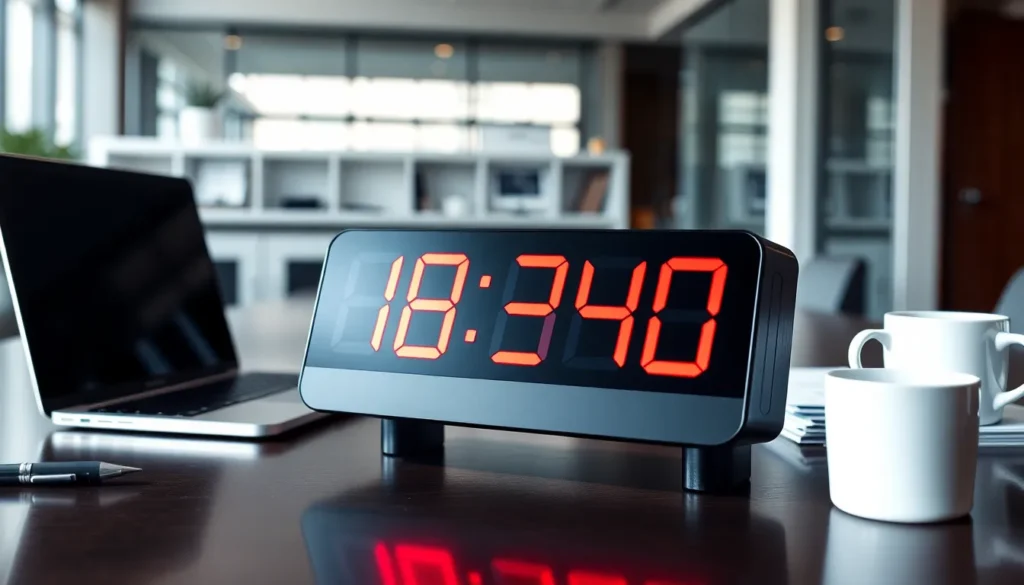Ever found yourself in a race against time, glancing at the clock like it’s a contestant on a game show? If you’re wondering how much time’s left until the elusive 11:50, you’re not alone. Whether it’s a meeting that feels like a never-ending saga or a lunch break that’s just around the corner, knowing the countdown can make all the difference.
Table of Contents
ToggleUnderstanding Time Calculations
Time calculations form an essential part of managing daily activities. Knowing how much time remains until specific moments enables better planning and reduces stress.
The Concept of Time
Time represents a sequence of events, measured in hours and minutes. Clocks and watches provide a standard means for individuals to track this progression. Each minute counts, whether waiting for a meeting to end or anticipating a lunch break. Understanding time helps in setting priorities and making decisions. Events often hinge on precise timing, creating a connection between the present moment and future plans. Effective time concepts lead to increased awareness surrounding deadlines and appointments.
Importance of Time Management
Time management impacts productivity and efficiency in personal and professional settings. Utilizing tools such as calendars helps individuals allocate time effectively. Employees often find they achieve more when they prioritize tasks based on urgency. Meeting deadlines consistently builds trust and reliability. Additionally, successful time management reduces feelings of being rushed or overwhelmed. One effective strategy includes breaking tasks into smaller segments to enhance focus. Mastering time management ultimately leads to greater satisfaction and a more balanced life.
How to Determine Time Until 11:50

Understanding how much time remains until 11:50 enhances efficiency and reduces stress, especially during busy moments.
Using a Clock
A clock serves as a straightforward tool for determining time until 11:50. By observing the current time, one can quickly assess the minutes left. For instance, if it’s 11:30, that means 20 minutes remain. Digital clocks display time in hours and minutes, making calculations easier. Analog clocks also provide a visual representation, allowing one to visually gauge the time left. When using a clock, keep an eye on both hours and minutes for precise tracking.
Calculating Time Intervals
Calculating time intervals involves simple math. Start by noting the current time. Next, convert the hours and minutes to a single unit, like minutes. For example, if it’s 11:20, that equates to 20 minutes until 11:50. Subtracting the current minutes from 50 yields the remaining time. In scenarios where current time exceeds 11:50, subtract from 24 hours to find the next occurrence of 11:50. Regular practice enhances accuracy in these calculations, promoting better time management.
Practical Scenarios for Time Until 11:50
Understanding the time left until 11:50 can significantly impact daily routines and productivity. Accurate time awareness fosters a smooth flow of activities.
Daily Routines
Managing daily tasks effectively often depends on knowing how much time remains until a specific moment like 11:50. Rushing through breakfast might lead to leaving the house late. Setting alarms or reminders to signal time for various activities helps maintain a structured routine. Consider establishing a morning timetable that includes time allocated for each task, ensuring tasks get completed without stress. Regularly checking the clock aids in keeping a steady pace, especially in busy mornings. Selecting practical strategies for time management reduces the chances of feeling overwhelmed and promotes better preparedness.
Scheduling Meetings
Calculating time until 11:50 is crucial for scheduling meetings efficiently. Understanding this specific time can help individuals allocate sufficient time for preparation. Planning meetings to conclude before 11:50 ensures participants can transition smoothly to the next activities. It’s wise to keep an eye on the clock during discussions, which maintains awareness of the allotted meeting duration. Starting promptly allows for a more productive session and conveys respect for everyone’s time. Encouraging punctuality among participants fosters a culture of reliability and professionalism. Opting for brief agendas also aids in sticking to the timeline, enhancing overall efficiency throughout the day.
Tools and Resources
Several tools and resources help in tracking time until 11:50. These options enhance time management skills effectively.
Time Calculators
Time calculators provide quick calculations for the minutes remaining. Users input the current time, and the calculator gives the exact countdown. Many online platforms offer these tools for free. These calculators streamline the process, ensuring accuracy when planning activities.
Mobile Apps
Mobile apps specializing in time tracking offer convenience and usability. Users can set countdown timers for specific events like 11:50, receiving notifications as the time approaches. Popular apps include Clock, Timer, and Reminder, providing customizable features. Each app allows users to prioritize tasks, helping to maintain focus throughout the day. These resources support efficient time management, reducing the chances of interruptions during critical moments.
Understanding how much time is left until 11:50 can significantly enhance daily productivity and reduce stress. By mastering time calculations and utilizing available tools, individuals can improve their time management skills. This awareness not only aids in scheduling but also fosters a sense of control over one’s day.
Embracing effective time tracking strategies allows for smoother transitions between tasks and promotes punctuality. Whether through analog clocks, digital timers, or mobile apps, staying mindful of the time can lead to a more organized and fulfilling routine. Ultimately, prioritizing time management contributes to a balanced lifestyle, ensuring that each moment is maximized for success.





